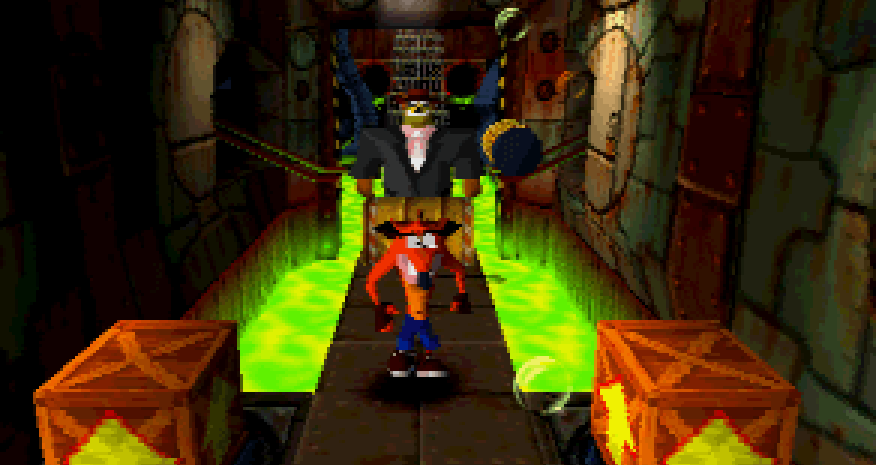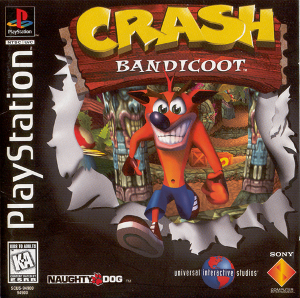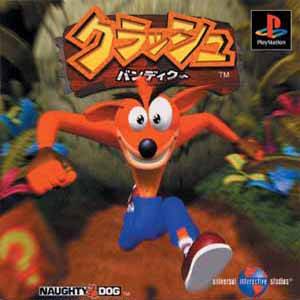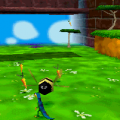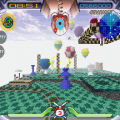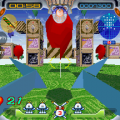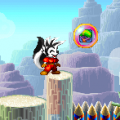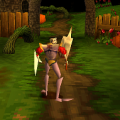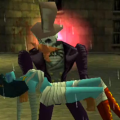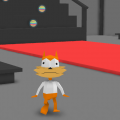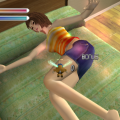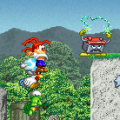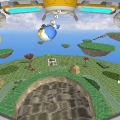Nowdays, it’s easy to lump Crash Bandicoot into the pile of failed mascots that Bubsy, Aero the Acrobat, and Gex lie somewhere in. It’s to be expected with a franchise that’s been passed around from developer to developer, few of which seemed to know quite what to do with the character. It doesn’t help, either, that the series would end up in the hands of Activision, a company not exactly known for their willingness to experiment. Despite these setbacks, a fanbase for Crash still remains, and with a new generation taking their first look at the series through its PS4 remastering, perhaps there’s still hope we’ll see a revival of the series. The original games shouldn’t be neglected, however, as they’re not only greatly influential works that helped kickstart the 3D era, but are one of the few games that truly achieved their status as being “interactive cartoons”.
To really understand just how important these games were, it’s necessary to set some background. It’s the middle of 1996, and Super Mario 64 has not only launched a new Nintendo console, but also created a spectacular first entry in an entirely new subgenre. Meanwhile, Sega has left their mascot Sonic behind to enter the world of 3D with Nights into Dreams. This leaves the Playstation, who at this point has to settle for Polygon Man and Battle Arena Toshinden’s Sofia to serve the role of mascots, neither of which could be called particularly marketable compared to Mario. Further, the Playstation, while currently the best option for 3D gaming before the time of the N64, is also lacking when it comes to this new world of 3D platforming.
This is where Naughty Dog comes in, formerly known for subpar text adventures, subpar MK clone Way of the Warrior, and Rings of Power, forever immortalized as “that game where you can make the woman in the intro show her breasts”. From their works spawn Crash Bandicoot, simultaneously filling the Playstation’s requirements of a proper 3D platformer and a viable mascot for the system. Really, the series continued right from where Sonic’s hiatus in the Saturn era begin, and the two series share a lot of similarities. Both series push the hardware they’re on for one singular purpose, in this case, its highly impressive cartoon graphics. From there, both series sought to compete directly with the latest Mario title, while offering a very different sort of gameplay.
What the games might lack in Sonic’s speed or Mario 64’s wide open worlds, they make up for in visual spectacle. While Sonic had a somewhat softer look, taking more from Felix the Cat, Naughty Dog followed more from the wackier, somewhat edgier works of Tex Avery. While other mascots have to have to have cartoons written around their own games, the games feel like they were tailor made for a series, with wild looking characters and plenty of slapstick comedy. While an unused animated intro for the original game can be found online, it failed to create interest for an actual series, for better or worse.
One of the franchise’s primary strengths is the approach taken to the marsupial himself. While the promotional material might make you try to believe otherwise, he’s never presented in his own games as being particularly “cool” or “hip”, and he never even speaks a full sentence. He’s a dopey, somewhat dense goofball prone to injuring himself, and it’s his zany mannerisms and exaggerated facial expressions that sell the character, not any sort of ‘tude, catchphrase, or product placement. His supporting cast, on the other hand, sport exaggerated looks and speak with voices that would fit perfectly into any Saturday morning cartoon. The games also feature some pretty entertaining cutscenes, aided by the fact that cartoon alumni Clancy Brown voices a couple of the villains.
So many other games have prided themselves as being “interactive cartoons”, however, and it’s rare that cartoon and game come together quite perfectly. If any series has claimed that title, though, it may very well be this one. The somewhat simplistic level design the series has is made up for by its sheer visual spectacle, in which not a single polygon is wasted. It’s a series that’s visually aged far more gracefully than most of the other titles in the Playstation library. Generally, if there’s only one thing you should take from the series, it’s the sheer amount of programming involved to make the somewhat aged Playstation hardware capable of such feats.
None of that would matter if the gameplay couldn’t match up, as seen in such cases as the Bubsy series. While the first game has its issues, its sequels are highly solid platformers, with tight controls, plenty of secrets, and a healthy dose of variety. If there’s any particular series the games could be truly compared to, it would be the Donkey Kong Country series. Anybody familiar with those games would find a lot to like here, such as the emphasis on finding hidden secrets and the constant shifts in gameplay styles. Unlike Mario 64 and the plethora of games that copied it, the Crash games take and evolve the concepts seen on display during the 16-bit era and simply add a new dimension, creating something that feels somewhat familiar.
The series as a whole is generally fairly light on plot, and unlike Sonic’s elaborate storylines, the games only get wackier and sillier with every new title. Most entries revolve around the nefarious schemes of the evil Dr. Neo Cortex, who seeks to gather a collection of power crystals that’ll allow him to take over the world. Opposing Cortex is Crash, one of the doctor’s former creations. Given that Crash could be charitably described as “reckless”, he has to be guided by Aku Aku, a spirit of a witch doctor trapped inside a wooden mask. As the series progresses, new characters are introduced, from Crash’s sister Coco to more of the many colorful henchman among the doctor’s employ that make up the boss battles. None of the games take themselves particularly seriously, however, and unlike Sonic, the games released past the PS1 era only get goofier and wackier with every game.

Somewhere on a chain of islands off the coast of Australia, the evil Neo Cortex and his assistant, Nitrus Brio, are attempting to mutate Australian wildlife into their own personal army of super soldiers. Let’s be honest: given the reputation of Australian wildlife, this is far from the worst evil plan ever devised. A bandicoot named Crash apparently lacks the brain power to lead Cortex’s army, and after a brief scuffle, ends up falling out of a castle window. Unfortunately, Cortex still has Tawna, Crash’s overly endowed bandicoot girlfriend. After washing up on a beach two islands away from Cortex’s castle, it’s up to the bandicoot to make his way back, trekking through the island’s beaches, and a native village, before making it through Cortex’s factories and towards the castle. All of this is explained through a short in-engine cutscene during the demos, but besides that, that’s almost all the plot the game has to offer.

The game actually only makes use of a couple of inputs, not counting the Triangle button that brings up the HUD. The Square button activates Crash’s spin attack, his main mode of offense against the enemies encountered across the island. The spin itself is a pretty handy, since it stays active for long enough that worrying about knowing just when to attack is rarely an issue. It’s not invincible, however, and enemies wearing spikes may require a more traditional stomping, instead. These are the only moves you’re ever offered, and it can seem somewhat sparse compared to Mario 64’s wide array of acrobatic abilities.

The simple controls, mixed with the game’s somewhat basic level design, bring more to mind a game from the 16-bit era that just so happens to have a third dimension added to it. Generally, progress through the levels of the island is made by moving forward in a straight line, with movement to the left or right halted by two surrounding walls. It’s not always just a corridor, however, as you’ll occasionally come across forks in the road ahead, which contain items and secrets needed for full completion. It’s an unusual approach, but it also helps to alleviate most of the camera controls that early 3D platformers were notorious for, since the game’s camera generally shifts automatically to give you the best view. Unfortunately, it doesn’t account for the player moving backwards very well, which can make it pretty tough to see what might be behind you.

The wooden crates scattered across the island are generally the game’s major collectible, and give up their bounty when jumped upon or spun into. Most contain Wumpa Fruit, the requisite platformer pick-up that gives you an extra life for a hundred collected, while others have extra lives or serve as checkpoints. There’s other sorts of crates that get placed in interesting ways, too, like bouncy ones that can be jumped on for extra height, striped crates that can only be bounced on a limited number of times before they break, and an unbreakable steel variant. Most dangerous of all are the red TNT crates, which will either trigger in three seconds if bounced on, or will explode right away if they’re spun into, most likely blowing Crash into tiny pieces.

By default, Crash can only take one hit before death. His only source of protection are boxes that contain the mask of Aku Aku, which serves as a hit point. Once you have the mask in tow, he’ll start to float behind Crash, and should you take damage, the witch doctor will take the hit and disappear. If you find another Aku Aku crate while you already have him, he’ll turn gold, thus allowing him to absorb two hits. If you can keep a hold of three masks, Aku Aku will attach himself to Crash’s face, making him invincible for a short time and giving him the power to dash right through crates and enemies without stopping.

When it comes to the first few levels, the difficulty curve starts off fairly gentle, with simple hazards and plenty of extra lives and Aku Aku masks on hand. It’s by “Boulders” where the game starts to get particularly mean. This is the first of the many “chase” levels that appear throughout the series, and has Crash dashing frantically towards the camera from a runaway boulder. The problem with stages like these is that it’s often difficult to see what’s coming up, and making more than a single mistake will allow the boulder to catch up to you and kill you. It’s generally from this point onwards where the game’s generous supply of extra lives quickly starts to dwindle, to the point that they’ll become just as precious as the gems you’re seeking.

A lot of the game’s level design is made up of slow, methodical platforming. This isn’t a game that rewards speed, and nine times out of 10, dashing forward without being patient will probably lead to your death. Platforms need to be lept across at just the right moment, traps need to be avoided when the coast is clear, and enemies often need to be attacked when they’re vulnerable. You won’t often get more than one mistake before you lose a life, and checkpoint crates aren’t always easy to come by. It doesn’t help that Crash’s movement sometimes feels a little slippery, and there are points where it feels like he’ll slide right off the edge of a platform to his death, or walk just a little further than you intended for him right into a hazard.

Still, the game does a decent job of varying up its level design from time to time. One particular highlight is “Road to Nowhere”, where Crash has to traverse a rapidly rotting bridge suspended over a foggy abyss. Some levels also have him ride a charging boar through a village, forcing you to quickly leap and weave through a brutal series of obstacles, Turbo Tunnel style. Some levels take on a sidescrolling view, complete with alcoves in the background that you can hide in to avoid dangers. There’s just enough twists in the usual platforming that things stay interesting, with a lot of different switches in scenery that go with the increase in difficulty.

You also get a few different encounters with Cortex’s henchmen, all of which are pretty unique. Generally, the bosses aren’t as difficult as the levels that precede them, since their patterns tend to be fairly predictable. Boss encounters are established pretty early on in the series as having you run around and avoiding the boss’s attacks, waiting for them to do something stupid that leaves them open, hitting them, and repeating until defeated. Still, the game does a lot of interesting fights with that particular style. The most interesting of the battles would probably have to be the fight against Pinstripe Potaroo, a mobster of an Australian rodent who sprays machine gun fire around his office, forcing Crash to cower behind the furniture, popping out to smack him when his gun jams.

If you run out of lives, continuing will bring you back to your last save point, which ties right in to this game’s rather harsh save system. Certain levels have crates that will contain icons of either Tawna, N. Brio, or in certain secret areas, Cortex. Picking up three of the same icon will send you to a short 2D bonus stage, where you’ll navigate a series of small pits while breaking crates and grabbing more Wumpa fruit. However, it’s only during one of Tawna’s bonus areas that you can have the chance to save, and should you die in a bonus area, or never reach it at all, you can’t ever revisit that particular zone. This pretty much puts a hard limit to how many times you can actually save. Even if you manage to reach every single save point, using a continue will still put you back several levels anyway, and with how difficult some stages can get, that can be a lot of lost progress.

Just clearing the levels isn’t good enough, either. In the spirit of the titles that inspired it, you’ll need to scour every level to earn 100% completion and the game’s best ending. In this case, you’ll need gems, which can only be earned by destroying every crate in a level, all without losing a life. That would be pretty harsh in itself, if it wasn’t for the fact that you won’t be able to tell how many crates you’ve destroyed until you clear a stage. You’ll also need to make certain you don’t move so far ahead into the level that you can no longer backtrack, or end up in a situation where you can’t reach a crate.

Some levels will reward you with colored gems instead of the usual clear ones, and you’ll need these to open up certain pathways to new areas that hide even more crates. Finally, there’s two extra secret Cortex bonus areas that’ll give up keys to secret levels upon their completion. It all adds up to a monumental amount of effort for full completion, which is only a little sweetened by the fact that every gem collected gives you another opportunity to save your progress. Should you earn every gem, however, the penultimate level will open up a new pathway that lets you bypass the final battle with Cortex entirely, as well as getting an extended ending that details the fate of the game’s characters, in a goofy “Where are they now” fashion. Since a sequel was uncertain, everybody ends up pretty well, although the game ominously notes that “mad scientists are harder to squash than cockroaches”.
If there’s anything that makes up for the game’s almost maddening difficulty at points, it would have to be just how good it looks, especially given how early the game came out in the PS1’s lifetime. There are a multitude of hardware tricks and exploits that literally push the system to its limits, and the result is a game that still looks surprisingly great even today. The camera is placed where you can always get a view of just how much detailed scenery is around you, which almost never slows the game down, nor does it ever stop to load during gameplay. It’s the smaller touches that really help the world come alive, however, like the flowing water on the river stages, or the lighting effects of the torches in the ruins stages.

The music is similarly unique, taking a more subdued, ambient approach compared to similar games. It’s got a very distinct sound to it, making use of xylophones and digeridoos in the early levels, before slowly moving into more electronic sounds and theremins in the final stages. It’s got a similarly off-beat style to the game’s visuals, and while it’s not usually something you’ll keep around to listen to later, there are very few games that sound quite like it. The sound effects are similarly unique, from the satisfying crunch of smashed boxes, to the incomprehensible vocalizations of the Aku Aku masks you pick up. Probably one of the best parts of the sound design, given mascots of ages past, is that Crash himself almost never utters a single word, aside from a “WOAH!” upon death that’ll soon never leave your head.
Overall, the original title is a fine start, but much like any other long running series, the first entry is always the one that’s the hardest to come back to. In a lot of ways, its similarity to the platformers of the 16-bit era is just as charming as it can be annoying. It can be a heavy challenge at times, but there’s a solid platformer at its core. Thankfully, its worst issues, most notably the punishing way it handles saving your game, would be the first things adjusted quickly by the game’s sequels. So while it’s still a decent game for its time, it’s hardly necessary to play through unless you’re out to play all the Crash games, or you can handle this particular entry’s challenge.
The Japanese version of the game alters quite a few things to make the character more appealing to its audience. Most of these would carry over to future Japanese releases in the series, as well. Crash actually gets several voiced lines in this version, and breaking certain Aku Aku crates will have the mask offer gameplay tips. Some of the soundtrack has been replaced entirely, too, due to a mandate from Sony’s Japanese branch. On the gameplay end of things, some levels have had their positions changed around.

